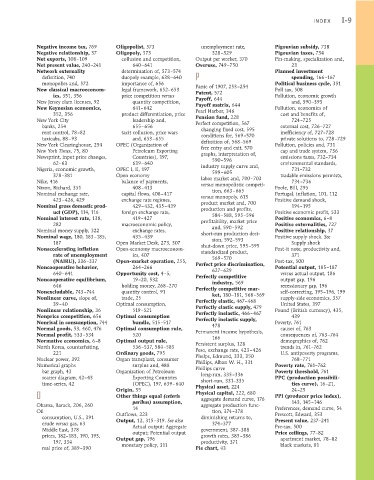Page 919 - Krugmans Economics for AP Text Book_Neat
P. 919
INDEX I-9
Negative income tax, 769 Oligopolist, 573 unemployment rate, Pigouvian subsidy, 738
Negative relationship, 37 Oligopoly, 573 328–329 Pigouvian taxes, 734
Net exports, 108–109 collusion and competition, Output per worker, 370 Pin-making, specialization and,
Net present value, 240–241 640–641 Overuse, 749–750 23
Network externality determination of, 573–574 Planned investment
definition, 740 duopoly example, 638–640 P spending, 166–167
monopolies and, 572 importance of, 656 Political business cycle, 351
New classical macroeconom- legal framework, 652–653 Panic of 1907, 253–254 Poll tax, 508
Patent, 572
ics, 351, 356 price competition versus Pollution, economic growth
New Jersey clam licenses, 92 quantity competition, Payoff, 644 and, 390–393
Payoff matrix, 644
New Keynesian economics, 641–642 Pearl Harbor, 346 Pollution, economics of
352, 356 product differentiation, price cost and benefits of,
New York City leadership and, Pension fund, 228 724–725
Perfect competition, 567
banks, 254 655–656 changing fixed cost, 595 external cost, 726–727
rent control, 78–82 tacit collusion, price wars conditions for, 569–570 inefficiency of, 727–728
taxicabs, 88–93 and, 653–655 private solutions to, 728–729
New York Clearinghouse, 254 OPEC (Organization of definition of, 568–569 Pollution, policies and, 731
free entry and exit, 570
New York Times, 75, 80 Petroleum Exporting graphs, interpretation of, cap and trade system, 736
Newsprint, input price changes, Countries), 197, 590–596 emissions taxes, 732–734
62–63 639–640 environmental standards,
Nigeria, economic growth, OPEC I, II, 197 industry supply curve and, 731–732
599–605
378–381 Open economy tradable emissions permists,
Nike, 416 balance of payments, labor market and, 700–703 734–736
versus monopolistic competi-
Nixon, Richard, 351 408–413 tion, 663–665 Poole, Bill, 295
Nominal exchange rate, capital flows, 408–417 versus monopoly, 613 Portugal, inflation, 101, 112
423–426, 429 exchange rate regimes, Positive demand shock,
Nominal gross domestic prod- 429–432, 435–439 product market and, 700 194–195
production and profits,
uct (GDP), 114, 116 foreign exchange rate, Positive economic profit, 533
584–588, 595–596
Nominal interest rate, 138, 419–427 profitability, market price Positive economics, 6–8
282 macroeconomic policy, Positive externalities, 727
and, 590–592
Nominal money supply, 322 exchange rates, short-run production deci- Positive relationship, 37
Nominal wage, 180, 183–185, 435–439 sion, 592–593 Positive supply shock. See
187 Open Market Desk, 273, 307 Supply shock
Nonaccelerating inflation Open-economy macroeconom- shut-down price, 593–595 Post-it note, productivity and,
standardized product,
rate of unemployment ics, 407 569–570 371
(NAIRU), 336–337 Open-market operation, 255, Post-tax, 500
Noncooperative behavior, 264–266 Perfect price discrimination, Potential output, 185–187
627–629
640–641 Opportunity cost, 4–5, versus actual output, 186
Noncooperative equilibrium, 19–20, 532 Perfectly competitive output gap, 196
industry, 569
646 holding money, 268–270 recessionary gap, 196
Nonexcludable, 743–744 quantity control, 91 Perfectly competitive mar- self-correcting, 195–196, 199
ket, 180–181, 568–569
Nonlinear curve, slope of, trade, 25 Perfectly elastic, 467–468 supply-side economics, 357
39–40 Optimal consumption, United States, 397
Nonlinear relationship, 36 519–521 Perfectly elastic supply, 479 Pound (British currency), 435,
Perfectly inelastic, 466–467
Nonprice competition, 656 Optimal consumption Perfectly inelastic supply, 439
Nonrival in consumption, 744 bundle, 515–517 478 Poverty, 761
Normal goods, 53, 460, 476 Optimal consumption rule, Permanent income hypothesis, causes of, 763
Normal profit, 533–534 520 166 consequences of, 763–764
Normative economics, 6–8 Optimal output rule, Persistent surplus, 128 demographics of, 762
North Korea, counterfeiting, 536–537, 584–585 Peso, exchange rate, 423–426 trends in, 761–762
221 Ordinary goods, 795 U.S. antipoverty programs,
Nuclear power, 392 Organ transplant, consumer Phelps, Edmund, 333, 350 768–771
Phillips, Alban W. H., 331
Numerical graphs surplus and, 488 Phillips curve Poverty rate, 761–762
bar graph, 43 Organization of Petroleum long-run, 335–336 Poverty threshold, 761
scatter diagram, 42–43 Exporting Countries short-run, 331–335 PPC (production possibili-
time-series, 42 (OPEC), 197, 639–640 Physical asset, 224 ties curve), 16–21,
24–25
O Origin, 35 Physical capital, 222, 680 PPI (producer price index),
Other things equal (ceteris
paribus) assumption, aggregate demand curve, 176 143, 145–146
Obama, Barack, 206, 260 14 aggregate production func- Preferences, demand curve, 54
Oil Outflows, 223 tion, 374–378 Prescott, Edward, 353
consumption, U.S., 391 Output, 12, 315–319. See also diminishing returns to, Present value, 237–241
crude versus gas, 63 Actual output; Aggregate 374–377 Pre-tax, 500
Middle East, 378 output; Potential output government, 387–388 Price ceilings, 77–82
prices, 182–183, 190, 193, Output gap, 196 growth rates, 385–386 apartment market, 78–82
197, 334 productivity, 371
real price of, 389–390 monetary policy, 311 Pie chart, 43 black markets, 81

